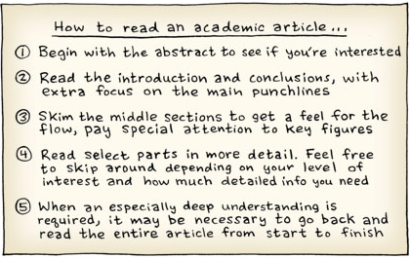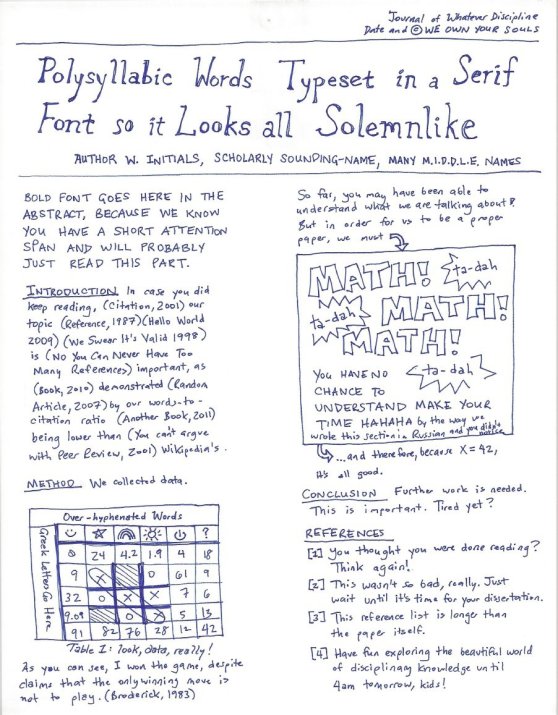* * * * * * * * * * * * * *
RESOLVED:
- Journal articles are intended to convey information. They shouldn’t have to be systematically attacked and interpreted (…then reinterpreted) by the reader.
- Abstracts and conclusions are less text-intensive than the body of the article, but are likely to be just as incoherent (less-structured, offering fewer figures). Overall, this detracts from their use.
- Images and figures should be the primary conveyors of information in any article. Terse prose is okay, and even encouraged, if meaning can be adequately conveyed with images.
I’m a huge fan of Bret Victor, particularly his paper “Scientific Communication as Sequential Art” (which is detailed in the first part of a lecture he did for the MIT Media Lab, “Media for Thinking the Unthinkable“). In it, Victor redesigns a scientific paper as a series of captioned, dynamic illustrations within a comic-like format. The general meaning of the paper is preserved, and the reader is more likely to understand the presented concepts. So, question: why hasn’t this been done for more journal articles, and for e-textbooks? Other question: why don’t we have textbooks specifically designed for digital reading?
Wolfram’s Demonstrations Project launched an attempt (sort of), presenting embeddable figures in a computable document format. The CDF documents are free to create within Mathematica, and viewable by anyone who downloads the CDF player; however, there is little likelihood that the software’s code will be open-source — Mathematica (the tool for creating the documents) certainly isn’t — and I’m not aware of any projects working to create an alternative. More complaints: the Wolfram demonstrations project just focuses on visual representation of equations, and direct manipulation, but not on physical concepts and meaning. Lots of pretty pictures, little understanding.
Physics, mathematics, biology, finance, and statistics are all obvious arenas for change in values over time — and all are heavily represented on Wolfram’s site. There are even examples in the social sciences, in investment planning, and in journalism! It’s troubling to see the earth sciences, astronomy, and materials science so under-represented, though — and especially troubling to see that the visualizations are being used on a small scale (i.e., one or two per page of obfuscated text, sans explanation). Nothing akin to the sequential, related images and understandable prose in Victor’s presentation.
Speaking to what I know best: Geology is certainly an area where physical changes can (and should!) be dynamically and visually represented. Descriptions of lithologies are inadequate; and, as helpful as large scale geologic maps and cross-sections happen to be, they would be infinitely more understandable if dynamically represented. Can you imagine seeing a cross-section as its layers are deposited and subsequently deformed, over time? With mouse-overs detailing properties of lithology, prospective stresses and strains, changes in porosities and permeabilities as strata are buried and undergo pressure? Now imagine seeing that in three dimensions — and being able to scroll through the cross-sections in space, and in time. Badass.
A scientist is only as good as her tools; and right now, the scientific community’s primary tool for communication is a low-bandwidth, almost incomprehensible, static page. We can and must do better.
If you know of any software that speaks to these issues — preferably open-source software — please let me know! I’d love to learn more about it, and to use it.
* * * * * * * * *
PS, for those who would be interested: purposefully not mentioning hyrdrogeology (i.e., the inadequacies of MODFLOW). That’s a whole ‘nother can of worms, for a whole ‘nother blog post. (It hasn’t been modified in ages! The user-interface is terrible! Hydrologic visualization is terrible! Get off my lawn!)


You must be logged in to post a comment.